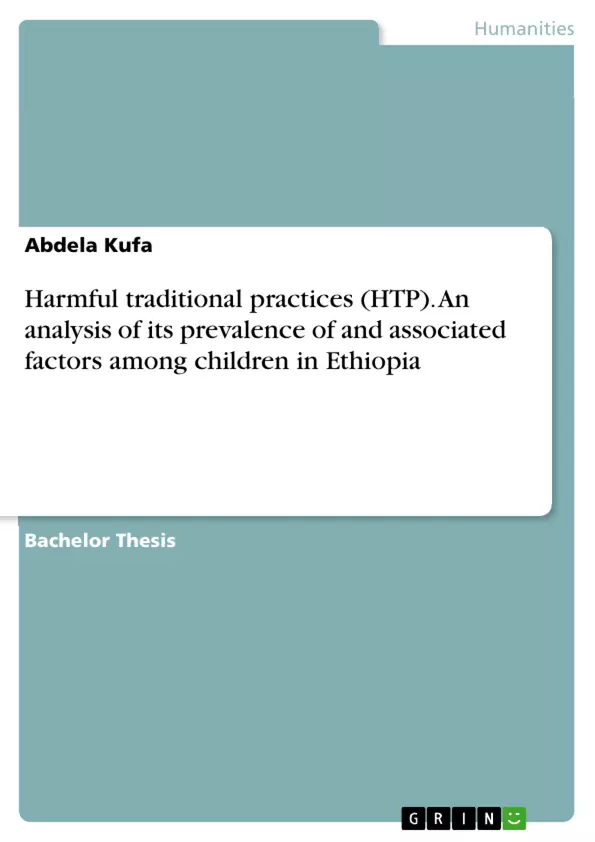This empirical study was designed to assess prevalence and associated factors of harmful traditional practices (HTP) on children less than 15 years in the Fentale District, Oromia Region.
Harmful traditional practices encompass a range of abuse which results in physical and psychological harm, disability and even death for significant numbers of women. Following forced marriage, a woman may be abused by her husband and sometimes, by her in-laws. The health consequences are considerable and can include physical, emotional and psychological harm which can be chronic or acute. While child marriages are declining on girls under age 15, fifty million girls could still be at risk of being married before 15th birth day in this decade ,complications of pregnancy and child birth are the main causes of death on adolescent girls age 15-19 years old in developing countries and 30 million girls are at risk of undergoing Female Genital Mutilation(FGM) in the next decade half of the countries where FGM Is practiced; majority of girls were cut before age 5.
In Ethiopia more than one-third of ever-married women (35 percent) report that they have experienced physical emotional or sexual violence from their husband, sixty-five percent of women age 15-49 are circumcised,8% of girls married before age 15 and 84.3% of children’s are experiencing uvulectomy. As a result of high prevalence of HTPs in Ethiopia many health consequences like hemorrhage, damage to nearby structures, tetanus, heavy scarring ,recurrent infections, HIV/AIDS, obstructed labor, fistulae, depression, suicide, and even death occurs in significant number of women’s and children’s.
In this research, a community based cross-sectional study design with multistage sampling technique was undertaken. Data was collected by trained college students using a structured face to face interview and data collected was entered in to Epi info version and transferred to statistical package for social sciences( SPSS Version 21) for bivariate and multivariate analysis.
Inhaltsverzeichnis (Table of Contents)
- ACKNOWLEDGEMENT
- ACRONYMS.
- LISTS OF TABLE
- LISTS OF FIGURES
- ABSTRACT..
- INTRODUCTION
- Background...
- Statement of the Problem
- Justification of the study.
- LITERATURE REVEIW
- Magnitude of the problem........
- Sociological factors to harmful traditional practices
- Conceptual Frame Work.
- 3.0 OBJECTIVES.
- General Objective
- Specific Objective .........
- 4.0. METHODS AND MATERIALS..
- Study design and period
- Study area....
- Source and Study population
- Source population
- Study population ......
- Sample size and sampling procedures
- Sample size determination
- Sampling procedure.
- Variables of the study
- Dependant variable
- Independent variables
- Operational definitions......
- Data collection procedures..
- Data quality assurance
Zielsetzung und Themenschwerpunkte (Objectives and Key Themes)
This research thesis aims to assess the prevalence and associated factors of harmful traditional practices (HTPs) on children less than 15 years old in Fentale Woreda, East Shoa Zone, Oromia, Ethiopia. This study seeks to understand the extent to which HTPs affect children in this region and to identify the key social, economic, and cultural factors that contribute to the prevalence of these practices.
- Prevalence of Harmful Traditional Practices among Children
- Factors Associated with Harmful Traditional Practices
- Sociological and Cultural Determinants of HTPs
- Impact of Traditional Practices on Child Health and Well-being
- Strategies for Addressing and Reducing HTPs
Zusammenfassung der Kapitel (Chapter Summaries)
The introductory chapter provides background information on HTPs, their prevalence in Ethiopia, and the specific context of Fentale Woreda. The chapter outlines the statement of the problem, justifying the need for this study. Chapter 2 delves into a review of existing literature, exploring the magnitude of the problem of HTPs, highlighting sociological factors contributing to their prevalence, and examining the conceptual framework underpinning this research. The research objectives, both general and specific, are presented in chapter 3, outlining the key questions and aims of the study. Chapter 4 details the methodologies employed, including the study design, study area, source population, and sampling procedures. The chapter also defines the variables of the study, outlines operational definitions, and provides information on data collection procedures and data quality assurance.
Schlüsselwörter (Keywords)
Harmful Traditional Practices, Child Health, Prevalence, Associated Factors, Fentale Woreda, Ethiopia, Public Health, Social Determinants, Cultural Factors, Study Design, Methodology, Data Collection, Data Analysis.
- Citation du texte
- Abdela Kufa (Auteur), 2018, Harmful traditional practices (HTP). An analysis of its prevalence of and associated factors among children in Ethiopia, Munich, GRIN Verlag, https://www.grin.com/document/461602



